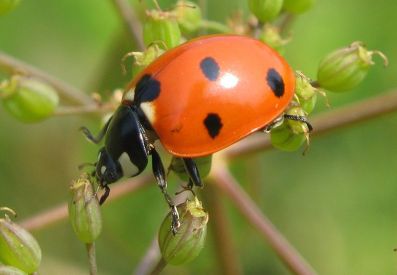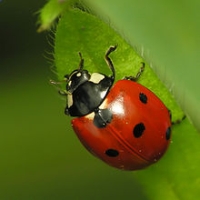Ladybugs are the organic gardeners best friend. Ladybugs have a huge appetite and will rid your garden of those pests that dine on your flowers and vegetables. If you have ladybugs in your garden then you know there is food. A ladybug will lay their eggs close to a food source, so that there young will have a better chance of finding food. So, what do ladybugs eat? A Ladybug’s main source of food is aphids, but commonly eat mites, mealybugs, armored scale, pit scales, and many other less known Scale insects that are generally too small to easily see with the human eye. In general Ladybugs do not make good pets due to there diet.
 Ladybugs are a familiar sight all across the world. They hide themselves during the winter but emerge again once the days start getting longer, making them a glad sign of spring. Because of their association with the end of winter and their bright red, polka-dotted appearance, they are some of the most popular insects around. Despite their name, ladybugs are not actually bugs. They belong to the beetle family and there are actually over 5000 different species of them! The species most Americans are familiar with, however, is the seven-spotted ladybug. They can also be called ladybirds or ladyflies and are a sign of good luck in most cultures.
Ladybugs are a familiar sight all across the world. They hide themselves during the winter but emerge again once the days start getting longer, making them a glad sign of spring. Because of their association with the end of winter and their bright red, polka-dotted appearance, they are some of the most popular insects around. Despite their name, ladybugs are not actually bugs. They belong to the beetle family and there are actually over 5000 different species of them! The species most Americans are familiar with, however, is the seven-spotted ladybug. They can also be called ladybirds or ladyflies and are a sign of good luck in most cultures.
Do ladybugs bite?
Table of Contents
Ladybugs may be portrayed as harmless mothers and little old ladies in cartoons, but they are actually carnivorous and ferocious predators on their own scale. Thankfully, they are completely harmless to humans. When threatened, they emit a foul-smelling yellow liquid that is, in fact, their blood.
 It can be toxic to some animals, but not humans, and it definitely gives birds and spiders second thoughts about eating a Ladybug! If you want to know what do ladybugs eat, or what to feed a pet ladybug, keep reading for the information you need.
It can be toxic to some animals, but not humans, and it definitely gives birds and spiders second thoughts about eating a Ladybug! If you want to know what do ladybugs eat, or what to feed a pet ladybug, keep reading for the information you need.
What do Ladybugs Eat?
Most people like ladybugs because they’re cute, but gardeners love them for a different reason. You may be wondering, “If those tiny little ladybugs are predators, what on earth is small enough for them to hunt?” The answer to that is an aphid. Aphids are insects that suck the sap out of plants. An infestation of them can destroy whole gardens and decimate crops. A single ladybug can eat up to 5000 aphids, which means they’re invaluable to farmers trying to control an aphid population. A good ladybug colony in a garden can eliminate an aphid problem in no time.
Not all ladybug species are carnivores, though. Some ladybugs also eat pollen, mildew or mushrooms. A few ladybugs, like the Mexican bean beetle, eat plants and are pests themselves. However, most ladybugs are predators and a welcome sight to gardeners. Ladybug eggs are small and yellow and are usually laid on the backside of a leaf, near aphid colonies. This ensures that young ladybug larvae will have a food source as soon as they hatch. Ladybugs also lay eggs that are infertile, or won’t hatch, amongst the fertile eggs as a first meal for their offspring.
What Can I Feed a Pet Ladybug?
Ladybugs are small, odorless and hardy survivors, making them a great first pet for kids. One way to help a ladybug as well as teach your children responsibility is to let them keep a few over the winter. A terrarium or specially-designed box is preferred, but you can also use an ordinary jar. Just remember to punch some holes in the lid to keep air flowing! Stock your ladybug house with some leaves and twigs to make them feel more at home. Ladybugs like humidity, so if you notice their enclosure starting to dry out, spritz some water on the leaves to keep things damp. Don’t worry about hunting down some aphids; captive ladybugs can be fed raisins that have been soaked for a few minutes, or small globs of honey. It’s best to not keep standing water around your pets. Instead provide them with a wet paper towel or cotton ball, which they will be able to drink from as needed. Then, in spring, let your kids release the ladybugs to rejoin their companions. If your kids enjoyed keeping these cute little bugs, you can order larvae and food for them from certain stores, which will allow you to keep them year-round!
